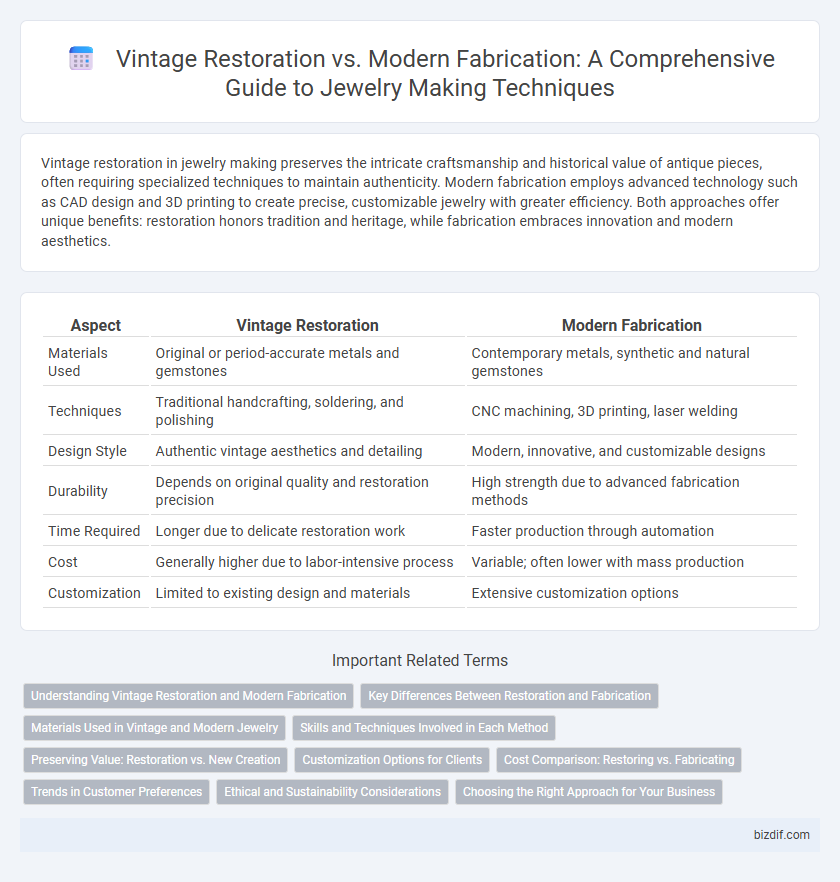Vintage restoration in jewelry making preserves the intricate craftsmanship and historical value of antique pieces, often requiring specialized techniques to maintain authenticity. Modern fabrication employs advanced technology such as CAD design and 3D printing to create precise, customizable jewelry with greater efficiency. Both approaches offer unique benefits: restoration honors tradition and heritage, while fabrication embraces innovation and modern aesthetics.
Table of Comparison
| Aspect | Vintage Restoration | Modern Fabrication |
|---|---|---|
| Materials Used | Original or period-accurate metals and gemstones | Contemporary metals, synthetic and natural gemstones |
| Techniques | Traditional handcrafting, soldering, and polishing | CNC machining, 3D printing, laser welding |
| Design Style | Authentic vintage aesthetics and detailing | Modern, innovative, and customizable designs |
| Durability | Depends on original quality and restoration precision | High strength due to advanced fabrication methods |
| Time Required | Longer due to delicate restoration work | Faster production through automation |
| Cost | Generally higher due to labor-intensive process | Variable; often lower with mass production |
| Customization | Limited to existing design and materials | Extensive customization options |
Understanding Vintage Restoration and Modern Fabrication
Vintage restoration involves carefully repairing and preserving antique jewelry to maintain its historical value and original craftsmanship. Modern fabrication uses advanced technology like 3D printing and laser cutting to create precise, contemporary designs with enhanced durability. Understanding these methods allows jewelers to balance heritage with innovation, ensuring both timeless elegance and modern functionality.
Key Differences Between Restoration and Fabrication
Vintage restoration in jewelry making involves preserving and repairing original pieces to maintain their historical authenticity and intricate craftsmanship, often requiring specialized skills in handling delicate, aged materials. Modern fabrication relies on advanced technology, such as CAD design and 3D printing, to create new pieces with precision and efficiency, emphasizing innovation and customization. Key differences include the restoration's focus on conservation and original materials, while fabrication prioritizes new production techniques and contemporary design flexibility.
Materials Used in Vintage and Modern Jewelry
Vintage restoration jewelry utilizes traditional materials such as high-carat gold, sterling silver, natural gemstones, and hand-cut diamonds, emphasizing authenticity and historical accuracy. Modern fabrication often incorporates advanced materials like titanium, stainless steel, synthetic gemstones, and innovative alloys, offering enhanced durability and versatile design options. The choice of materials directly influences both the aesthetic appeal and functional longevity of restored vintage pieces versus newly fabricated contemporary jewelry.
Skills and Techniques Involved in Each Method
Vintage restoration demands expertise in handcrafting techniques such as stone resetting, metal soldering, and polishing to preserve the original design and patina. Modern fabrication integrates advanced technologies like CAD modeling, 3D printing, and laser welding for precision and customization. Mastery of traditional skills ensures authenticity in restoration while proficiency in digital tools drives innovation in contemporary jewelry making.
Preserving Value: Restoration vs. New Creation
Preserving value in jewelry making often hinges on the choice between vintage restoration and modern fabrication. Vintage restoration maintains the original craftsmanship and historical significance, enhancing an item's provenance and market worth. Modern fabrication offers innovation and customization but may lack the intrinsic value tied to antique authenticity.
Customization Options for Clients
Vintage restoration offers clients the unique opportunity to preserve historical craftsmanship with authentic details, maintaining the original charm and character of each piece. Modern fabrication utilizing advanced techniques like 3D printing and CAD design allows for highly personalized and precise customization, enabling clients to create one-of-a-kind jewelry tailored to their exact preferences. Combining traditional restoration with contemporary customization expands the range of options, meeting diverse client desires for both authenticity and innovation in jewelry design.
Cost Comparison: Restoring vs. Fabricating
Restoring vintage jewelry typically incurs lower labor costs due to preserving existing materials, though intricate repairs can increase expenses significantly. Modern fabrication often demands higher costs stemming from custom design, new materials, and advanced technology like CAD and 3D printing. Cost efficiency depends on the piece's condition, complexity of restoration, and desired craftsmanship quality.
Trends in Customer Preferences
Customer preferences in jewelry making increasingly favor vintage restoration for its unique craftsmanship and historical value, appealing to those seeking nostalgic and one-of-a-kind pieces. Modern fabrication attracts buyers desiring customization and innovative designs enabled by advanced technology such as 3D printing and CAD software. Trends indicate a growing demand for ethically sourced materials in both vintage restoration and modern fabrication practices.
Ethical and Sustainability Considerations
Vintage restoration in jewelry making prioritizes ethical sourcing by repurposing existing materials, significantly reducing environmental impact through minimized mining and waste generation. Modern fabrication often relies on newly sourced metals and gemstones, which can contribute to ecological degradation and heightened carbon footprints. Sustainable practices favor vintage restoration for its alignment with circular economy principles and commitment to reducing resource depletion.
Choosing the Right Approach for Your Business
Selecting the ideal method between vintage restoration and modern fabrication depends on your business's target market and brand identity. Vintage restoration appeals to customers seeking unique, historically significant pieces with intricate craftsmanship, while modern fabrication emphasizes precision, scalability, and contemporary design trends. Evaluating factors such as inventory availability, production costs, and consumer demand will guide jewelers towards the most profitable and sustainable approach.
Vintage restoration vs Modern fabrication Infographic

 bizdif.com
bizdif.com